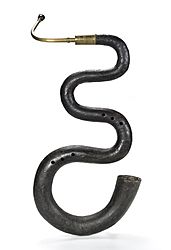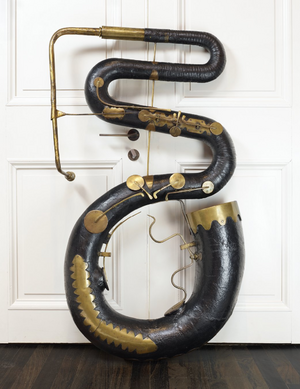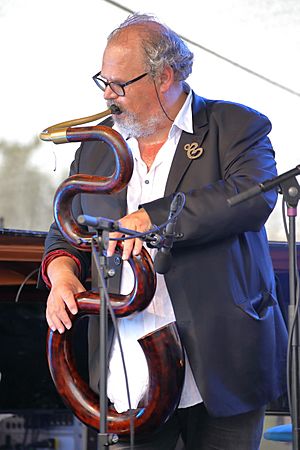Serpent (instrument) facts for kids

Serpent, late 18th century Italy. Civic Museum of Modena
|
|
| Brass instrument | |
|---|---|
| Other names |
|
| Classification | |
| Hornbostel–Sachs classification | 423.21 (aerophone sounded by lip vibration with keys) |
| Developed | Late 16th century |
| Playing range | |
|
<score lang="lilypond">
Range of the serpent; notes below C₂ are obtained with the embouchure{ \new Staff \with { \remove "Time_signature_engraver" } \clef bass \key c \major \cadenzaOn \tweak font-size #-2 a,,1 ^ "poss." c,1 \glissando c1 } </score> |
|
| Related instruments | |
| Musicians | |
|
|
| Builders | |
|
|
The serpent is a low-pitched early brass instrument developed in the Renaissance era with a trombone-like mouthpiece and tone holes (later with keys) like a woodwind instrument. It is named for its long, conical bore bent into a snakelike shape, and unlike most brass instruments is made from wood and covered with dark brown or black leather. A distant ancestor of the tuba, the serpent is related to the cornett and was used for bass parts from the 17th to the early 19th centuries.
The sound of a serpent is somewhere between a bassoon and a euphonium, and it is typically played in a seated position, with the instrument resting upright between the player's knees.
Contents
Construction
Although closely related to the cornett, the serpent has thinner walls, a more conical bore, and no thumb-hole. The original serpent is typically built in 8′ C from hardwood, usually tonewoods like walnut, maple, cherry, or pear, or sometimes softer woods like poplar. The whole instrument is assembled from several curved wooden pieces. Each piece is made by gluing two hollowed halves together to make a tubular segment, which are then bonded together and bound with an outer covering of leather.
The instrument uses a mouthpiece about the same size as a tenor trombone mouthpiece, originally made from ivory, horn or wood, which fits into the bocal or crook, a small length of brass tubing that emerges from the top wooden segment. It has six tone holes, in two groups of three, fingered by each hand. Early serpents were keyless, while later instruments added keys for additional holes out of reach of the fingers, to improve intonation and extend range.
Modern replicas are made by several specialist instrument makers, employing acoustic analysis and modern fabrication materials and techniques to improve the serpent's inherent intonation problems. Some of these techniques include use of modern composite materials and polymers, 3D printing, and changing the placement of tone holes. Swiss serpent maker Stephan Berger in collaboration with French jazz musician Michel Godard has developed an improved serpent based on studying well-preserved museum instruments, and also makes a lightweight model from carbon fibre. English serpent player and musicologist Clifford Bevan remarks that Berger's instruments are much improved, finally allowing players to approach the serpent "in partnership rather than in combat".
Contrabass serpent
The contrabass serpent, built one octave below the serpent and nicknamed the anaconda, was an English invention of the mid-19th century with no historical repertoire. The prototype instrument was built c. 1840 by Joseph and Richard Wood in Huddersfield as a double-sized English military serpent, and survives in the University of Edinburgh museum collection. During the serpent's modern revival, two more contrabass serpents were built in the 1990s by English maker Christopher Monk's workshop. Based on the original serpent ordinaire form, they were called "George" and "George II". The first, commissioned by musicologist and serpent player Philip Palmer, is now owned by American trombonist and serpent player Douglas Yeo and features in some of his serpent recordings.
History
There is little direct material or documentary evidence for the exact origin of the serpent. French historian Jean Lebeuf claimed in his 1743 work Mémoires Concernant l'Histoire Ecclésiastique et Civile d’Auxerre that the serpent was invented in 1590 by Edmé Guillaume, a clergyman in Auxerre, France. Although this account is often accepted, some scholars suppose instead that the serpent evolved from the large, S-shaped bass cornetts that were in use in Italy in the 16th century. It was certainly used in France since the early 17th century to strengthen the cantus firmus and bass voices of choirs in plainchant. This original traditional serpent was known as the serpent ordinaire or serpent d'église (lit. ordinary serpent – lit. church serpent). Around the middle of the 18th century, the serpent began to appear in chamber ensembles, and later in orchestras. Mozart used two serpents in the orchestra for his 1771 opera Ascanio in Alba.
Military serpents
Towards the end of the 18th century, the increased popularity of the serpent in military bands drove the subsequent development of the instrument to accommodate marching or mounted players. In England, a distinct military serpent was developed which had a more compact shape with tighter curves, added extra keys to improve its intonation, and metal braces between the bends to increase its rigidity and durability. In France around the same time several makers produced a serpent militaire initially developed by Piffault (by whose name they are also known) that arranges the tubing vertically with an upward turned bell, reminiscent of a tenor saxophone.
Upright serpents and bass horns
Several vertical configurations of the serpent, generally known as upright serpents (French: serpent droit) or bass horns, sprang up in the early 19th century. Retaining the same fingering and six tone holes of the original serpent, the layouts of these instruments more resemble that of a bassoon, with jointed straight tubes that fit into a short U-shaped butte joint, and an upward pointing bell.
Basson russe
The first of the upright serpents to appear was the basson russe, lit. Russian bassoon, although it was neither Russian nor a bassoon. The name is possibly a corruption of basson prusse since they were taken up by the Prussian army bands of the time. These instruments were built mostly in Lyon and often had the buccin-style decorative zoomorphic bells popular in France at the time, shaped and painted like a dragon or serpent head. Appearing around the same time in military bands was the serpent à pavillon (lit. bell serpent) which had a normal brass instrument bell, similar in flare to the later ophicleide.
English bass horn
The English bass horn, developed by French musician and inventor Louis Alexandre Frichot in London in 1799, had an all-metal V-shaped construction, described by German composer Felix Mendelssohn as looking like a watering can. He admired its sound however, and wrote for it in several of his works, including his fifth symphony and the overture to A Midsummer Night's Dream. The bass horn was popular in civic and military bands in Britain and Ireland, and also spread back into orchestras in Europe, where it influenced the inventors of both the ophicleide and later the Baß-Tuba.
Early cimbasso
The serpent appears as serpentone in early 19th century Italian operatic scores by composers such as Spontini, Rossini, and Bellini. In Italy it was replaced by the cimbasso, a loose term that referred to several instruments; initially an upright serpent similar to the basson russe, then the ophicleide, early forms of valved tuba (pelittone, bombardone), and finally by the time of Verdi's opera Otello (1887), a valve contrabass trombone.
Other upright serpents
In Paris in 1823, Forveille invented his eponymous serpent Forveille, an upright serpent with an enlarged bell section influenced by the (then newly invented) ophicleide. It is distinguished by being made from wood, brass tubing being used only for the leadpipe and first bend. It became popular in bands for its improved intonation and sound quality. In 1828 Jean-Baptiste Coëffet patented his ophimonocleide ("snake with one key"), one of the last innovations of the upright serpent. It solved one of the serpent's perennial problems, its difficult and indistinct B♮ notes, by building the instrument a semitone lower in B♮ but adding a large open tone hole that keeps the instrument in C until its key is pressed, closing the tone hole and producing a clear and resonant B♮.
The era of upright serpents was brief, spanning the first half of the 19th century from their invention to their replacement by the ophicleide and subsequent valved brass instruments. Richard Wagner used a serpent as a third bassoon in his 1840 opera Rienzi, but by the 1869 première of his Der Ring des Nibelungen cycle he was writing his lowest brass parts for tuba and contrabass trombone.
Contemporary revival
The serpent had all but disappeared from ensembles by 1900, but has enjoyed a modern revival of interest and manufacture since the mid-20th century. English historian and early music specialist Christopher Monk began building his own replica cornetts and serpents and playing them in historically informed performances. In 1968 he and a colleague devised a method of constructing them inexpensively from a composite wood-resin material, which helped to propel interest and their more widespread availability. In 1976 he established the London Serpent Trio with English players Andrew van der Beek and Alan Lumsden, performing new works and historical arrangements, both serious and whimsical, throughout Europe and North America. At the same time in France, historical instrument specialist Bernard Fourtet and jazz musician Michel Godard began promoting use of the serpent and established an academy for young serpent players.
Range and performance
\new Staff \with { \remove "Time_signature_engraver" } \clef bass \key c \major \cadenzaOn \tweak font-size #-2 a,,1 ^ "poss." c,1 \glissando c1
}</score>There is no real standard for the serpent's range, which varies according to the instrument and the player, but it typically covers the three octaves from C2 two octaves below middle C to C5. Good players can also extend the range downwards to A1 or even F1 by fingering the low C note with all holes covered, and "lipping" down with the embouchure.
Repertoire
The serpent began to appear in mid-20th century film scores, and in new chamber ensembles that feature period instruments. American film composer Bernard Herrmann used a serpent in the scores of White Witch Doctor (1953) and Journey to the Center of the Earth (1959), as did Jerry Goldsmith in his score for Alien (1979).
In jazz music, French musician and tubist Michel Godard has incorporated the serpent into his work.
Modern works for the instrument include a concerto for serpent and orchestra by English composer Simon Proctor, commissioned in 1987 to mark the first International Serpent Festival in South Carolina, where it was premièred by London Serpent Trio member Alan Lumsden in 1989. Also premièred at the festival was comic composer Peter Shickele's P.D.Q. Bach piece "O Serpent" written for the London Serpent Trio and an ensemble of vocalists. Boston Symphony Orchestra bass trombonist Douglas Yeo premièred "Temptation" for serpent and string quartet, written by his orchestra colleague, trombonist and composer Norman Bolter, at the 1999 International Trombone Festival in Potsdam, New York. Yeo also premièred a serpent concerto in 2008 by American composer Gordon W. Bowie entitled "Old Dances in New Shoes". Italian composer Luigi Morleo wrote "Diversità: NO LIMIT", a concerto for serpent and strings, which premièred in Monopoli, Italy in 2012.
Players
- Clifford Bevan, musicologist, member of the London Serpent Trio
- Bernard Fourtet, French early music specialist
- Michel Godard, jazz musician, tubist, serpent player
- Phil Humphries, London Serpent Trio, New London Consort
- Alan Lumsden, London Serpent Trio
- Andrew van der Beek, London Serpent Trio
- Steve Wick, tubist, professor of Serpent at Royal Academy of Music, London Serpent Trio
- Douglas Yeo, Boston Symphony Orchestra (retired), bass trombonist, serpent and ophicleide player
See also
 In Spanish: Serpentón para niños
In Spanish: Serpentón para niños










